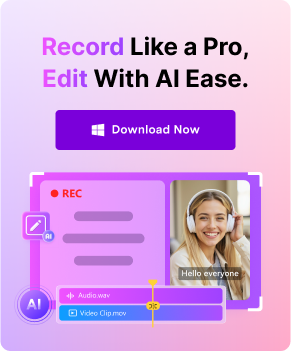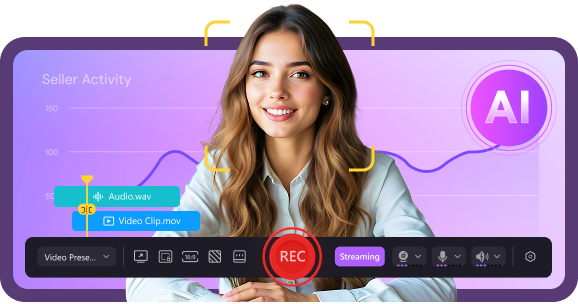OBS Virtual Camera is a powerful tool within OBS Studio that enhances video communication and streaming. It allows users to customize video sources, add overlays, and use scene transitions for a professional touch. Whether you're using OBS Virtual Camera Mac or Windows, it integrates seamlessly with platforms like Zoom and Google Meet. For those seeking an alternative, Wondershare DemoCreator offers beginner-friendly features like screen recording and virtual backgrounds. This guide provides an overview of OBS Virtual Camera’s features, setup, and uses.
In this article
- Part 1: What is an OBS Virtual Camera?
- Part 2: Descriptive Features of OBS Virtual Camera
- Part 3: How to Set Up OBS Virtual Camera on Windows
- Part 4: How to Set Up an OBS Virtual Camera Plugin on Mac
- Part 5: Using OBS Virtual Camera with Popular Platforms
- Part 6: Bonus: Wondershare DemoCreator
- Conclusion
- FAQs
Part 1: What is an OBS Virtual Camera?
OBS Virtual Camera is a feature within OBS Studio that enables users to output their custom video scenes as a virtual webcam feed. Instead of relying on a traditional webcam, this virtual camera allows users to combine multiple video sources, apply overlays, and add effects, all of which can be used in video conferencing or live streaming platforms.
The purpose of the OBS Virtual Camera is to provide enhanced customization and flexibility in video communication. It allows professionals, educators, and creators to produce polished and dynamic video outputs that elevate their online presence. Whether for business meetings, streaming gameplay, or creating tutorials, OBS Virtual Camera ensures a seamless and visually engaging experience. Its integration with platforms like Zoom, Google Meet, and Teams makes it a preferred tool for high-quality virtual interactions.

Part 2: Descriptive Features of OBS Virtual Camera
The OBS Virtual Camera is packed with features that enhance video communication and streaming, making it a powerful tool for professionals and creators alike. From customizable video sources to seamless integration with various platforms, it allows users to create polished and dynamic video outputs. Below are the key features that make the OBS Studio Virtual Camera stand out:

- Customizable Video Sources: Combine multiple video inputs such as webcams, screen captures, and pre-recorded videos to create a unified and professional video feed.
- Scene Transitions and Overlays: Enhance your video output with smooth transitions and dynamic overlays, ensuring an engaging experience for your audience.
- Integration with Various Applications: OBS Virtual Camera integrates seamlessly with platforms like Zoom, Google Meet, Microsoft Teams, and Skype, making it versatile for any use case.
- Support for Multiple Video Formats: The virtual camera supports a variety of video formats, ensuring compatibility with diverse devices and streaming platforms.
- Real-Time Video Adjustments: Easily tweak brightness, contrast, and other settings in real-time, ensuring optimal video quality during live sessions or recordings.
Part 3: How to Set Up OBS Virtual Camera on Windows
Setting up the OBS Virtual Camera on Windows is a quick and straightforward process. With just a few steps, you can transform your video feed into a dynamic and professional output, ready for use on platforms like Zoom, Google Meet, and Teams. Here’s how to get started:
Step 1Install OBS Studio
Download OBS Studio for free from the official website and install it on your Windows device. Follow the on-screen instructions to complete the installation. Once installed, launch OBS Studio to start setting up your virtual camera.

Step 2Add Video Sources
In OBS Studio, go to the Sources box at the bottom of the screen and click the + icon to add sources like Display Capture, Media Source, or a webcam. Arrange and customize these sources to create your desired virtual camera feed.

Step 3Start the Virtual Camera
Once your scenes and sources are prepared and ready in OBS Studio, it's time to start the virtual camera. Navigate to the Controls dock in the lower-right section of the screen and click the Start Virtual Camera button. Your virtual camera is now live and can be selected as a video input in platforms like Zoom, Microsoft Teams, or Google Meet.

Tips for Optimizing Settings
- Adjust Video Quality: Ensure your resolution and frame rate are appropriate for your device’s capabilities and the platform you are using.
- Monitor System Performance: OBS can be resource-intensive; close unnecessary programs to optimize performance during use.
- Test Your Setup: Before live sessions, test the OBS Virtual Camera with your chosen platform to ensure proper functionality and video quality.
- Use Scene Transitions: Set up smooth transitions between scenes to enhance your video’s professional appeal.
- Explore Plugins: Consider adding plugins like the OBS Virtual Cam Plugin for additional features and flexibility.
Part 4: How to Set Up an OBS Virtual Camera Plugin on Mac
Setting up the OBS Virtual Camera Plugin on Mac is a straightforward process that lets you create professional video feeds for Zoom, Skype, and other platforms. Follow these steps to set up and optimize your virtual camera.
Step 1Install OBS Studio
Download OBS Studio for macOS from the official OBS Studio website and install it on your Mac. Follow the on-screen instructions to complete the installation. Once installed, open OBS Studio to start configuring your virtual camera.

Step 2Set Up Sources and Scenes
After launching OBS Studio, set up the scenes and sources you want to use in your virtual camera feed. Go to the Sources box at the bottom of the interface and click the + icon to add sources like Media Source or Display Capture. Arrange these sources within your scene to prepare your layout for use in video calls and meetings.

Step 3Launch the Virtual Camera
Once your sources and scenes are configured, activate the virtual camera. Navigate to the Controls section in the bottom-right corner of the OBS interface and click Start Virtual Camera. The virtual camera is now enabled and can be selected as a video input in platforms like Zoom, Google Meet, or Skype.

Tips for Optimizing Settings
- Configure Video Settings: Adjust the resolution and frame rate under Settings > Video to ensure smooth performance.
- Simplify Layouts: Keep your scenes simple to reduce system resource usage and maintain optimal performance.
- Test Before Use: Always test the virtual camera with your chosen platform to ensure everything is working as expected.
- Use Hotkeys for Efficiency: Set up hotkeys under Settings > Hotkeys to quickly switch scenes, start/stop the camera, or control transitions during live sessions.
- Enable Audio Syncing: If you’re using audio alongside your virtual camera feed, ensure your audio sources are synced by adjusting settings in Advanced Audio Properties under the Audio Mixer panel.
Part 5: Using OBS Virtual Camera with Popular Platforms
1. Zoom
Zoom allows seamless integration with OBS Virtual Camera, enabling you to customize your video feed with layouts, backgrounds, and effects. This setup is perfect for enhancing your Zoom meetings with professional and creative visuals.
Setting Up OBS Virtual Camera in Zoom
Step 1Install OBS Studio and Configure for Zoom
Download OBS Studio from the official website and install it on your device. Launch OBS Studio after installation to begin configuring your virtual camera. Open OBS Studio and add the sources you wish to use in your Zoom calls. Click the + icon in the Sources box and add inputs like Display Capture, Media Source, or Webcam. Arrange these sources within the scene to create your desired video layout.

Step 2Set OBS as the Camera in Zoom
Launch Zoom and navigate to the Settings menu. Under the Video tab, choose OBS Virtual Camera from the Camera drop-down menu to set OBS as your video feed.

Step 3Activate the Virtual Camera and Share Content During Calls
Go back to OBS Studio and click Start Virtual Camera in the bottom-right Controls section. This action activates the OBS feed and syncs it with Zoom. Use the OBS interface to switch between scenes and sources during your Zoom meeting. This allows you to share various media, such as slides, videos, or live annotations, enhancing your presentation.

Tips for Effective Use in Zoom
- Optimize Resolution: Adjust OBS video resolution under Settings > Video to match Zoom’s requirements for better quality.
- Use Virtual Backgrounds: Add creative virtual backgrounds in OBS to enhance your Zoom calls.
- Enable Audio Filters: Improve audio clarity by applying noise suppression or equalization in OBS’s Audio Mixer.
- Practice Transitions: Use OBS’s scene transitions to switch smoothly between layouts during meetings.
- Test Your Setup: Run a test meeting in Zoom to ensure OBS Virtual Camera is working correctly before live calls.
2. Google Meet
Google Meet works effortlessly with OBS Virtual Camera, allowing you to present dynamic and interactive visuals. This integration ensures engaging and high-quality video communication during your meetings.
Setting Up OBS Virtual Camera in Zoom
Step 1Install OBS Studio and Configure Scenes and Sources
Download and install OBS Studio from the official website. Follow the setup instructions and launch the application once installed. In OBS Studio, click the + icon in the Sources box to add inputs like Display Capture, Webcam, or Media Source. Arrange these sources within the scene to create a professional layout for your Google Meet calls.

Step 2Select OBS in Google Meet
Open Google Meet, navigate to the Settings menu, and go to the Video tab. Select OBS Virtual Camera from the Camera drop-down menu to use it as your video source.

Step 3Activate the Virtual Camera and Start Meeting
Return to OBS Studio and click Start Virtual Camera in the Controls section at the bottom-right corner. This activates your virtual camera feed for Google Meet. Begin your Google Meet session, and participants will see the custom OBS feed with your selected sources and layout. Switch scenes in OBS as needed to share different media.


Tips for Effective Use in Google Meet
- Use Display Capture: Share screen content directly from OBS for tutorials or presentations.
- Improve Lighting: Use OBS’s color correction tools to adjust brightness and contrast for better video quality.
- Add Watermarks: Include branding elements like logos in OBS scenes for professional presentations.
- Test Compatibility: Run a test call in Google Meet to ensure OBS Virtual Camera integrates smoothly.
- Minimize Resources: Keep only necessary apps open while using OBS to reduce system load.
3. Microsoft Teams
Microsoft Teams supports OBS Virtual Camera, letting you share customized video feeds for meetings and presentations. Use this setup to enhance collaboration and create a polished, professional impression.
Setting Up OBS Virtual Camera in Microsoft Teams
Step 1Install OBS Studio and Add Sources in OBS
Download and install OBS Studio from the official website on your device. Complete the installation process and launch the software to begin setting up your virtual camera. In OBS Studio, use the + icon in the Sources box to add inputs such as Window Capture, Media Source, or Webcam. Customize and arrange these sources within the scene to create your desired video feed for Teams.

Step 2Configure Microsoft Teams Settings
Open Microsoft Teams and navigate to the Settings menu. Under the Devices section, select OBS Virtual Camera from the available camera options. This ensures OBS provides the video feed for Teams meetings.

Step 3Activate the Virtual Camera
Go back to OBS Studio and click Start Virtual Camera in the Controls dock. This action enables the OBS virtual feed and syncs it with Teams, making it accessible during your calls.

Step 4Start a Teams Meeting
Launch a meeting in Microsoft Teams. All participants will now see your OBS virtual camera feed, allowing you to share customized scenes and media.

Tips for Effective Use in Microsoft Teams
- Keep Layouts Simple: Use minimal scenes and sources for smoother performance during meetings.
- Use Window Capture: Share specific app windows like PowerPoint directly from OBS for focused presentations.
- Enable Audio Sync: Adjust audio delays in OBS to synchronize with your video feed.
- Hotkeys for Switching: Assign hotkeys in OBS for quick scene switching during Teams meetings.
- Run Performance Tests: Check CPU usage in OBS while running Teams to avoid lag during calls.
4. Skype
Skype’s compatibility with OBS Virtual Camera lets you share personalized and creative video feeds. This setup is ideal for showcasing media, adding fun effects, or maintaining a professional appearance during calls.
Setting Up OBS Virtual Camera in Skype
Step 1Install OBS Studio and Prepare Skype for OBS
Download OBS Studio from the official website and install it on your device. Launch the application after installation to configure your virtual camera. Update Skype to the latest version. Navigate to Settings > Calling > Advanced oand enable Allow NDI Usage to ensure compatibility with OBS Virtual Camera.

Step 2Add Sources in OBS
In OBS Studio, click the + icon in the Sources box to add inputs like Media Source, Display Capture, or Webcam. Arrange these sources to create a customized virtual camera feed for Skype.

Step 3Configure Skype Settings
Open Skype and go to the Settings menu. Under the Audio & Video tab, select OBS Virtual Camera as your video source from the Camera drop-down menu.

Step 4Start the Virtual Camera and a Call
Return to OBS Studio and click Start Virtual Camera in the Controls section. Begin a Skype call, and participants will see your customized OBS virtual camera feed.

Tips for Effective Use in Skype
- Use Media Sources: Play videos or display images through OBS’s Media Source for engaging conversations.
- Enable Noise Suppression: Apply audio filters in OBS to reduce background noise during Skype calls.
- Preview Scenes: Use OBS’s Studio Mode to preview scenes before switching them live in a call.
- Apply Effects: Experiment with OBS’s video effects to add creativity to your Skype feed.
- Optimize for Low Bandwidth: Adjust the resolution and bitrate in OBS to ensure smooth performance with slower internet connections.
Bonus about the Best Alternative: Wondershare DemoCreator
Wondershare DemoCreator is a versatile tool that combines screen recording, webcam integration, and editing capabilities. It’s designed for both beginners and professionals, offering features like virtual backgrounds, AI-powered effects, and intuitive video editing. This makes it an excellent alternative to OBS Studio for users who prefer a more streamlined interface.

Key Features
- Screen Recording: Record your screen and webcam feed simultaneously for tutorials, presentations, or content creation.
- Virtual Backgrounds: Replace or blur your background in real-time without requiring a green screen.
- Built-in Editor: Refine videos with tools like trimming, transitions, and effects directly within the software.
- Templates and Annotations: Add creative elements, including text annotations, shapes, and overlays, for engaging video outputs.
- Platform Compatibility: Works seamlessly with platforms like Zoom, Google Meet, and Microsoft Teams.
Step 1Launch and Select Mode
Start by opening Wondershare DemoCreator on your device. From the main interface, click the “Video Recorder” option. Then, select “Screen & Camera” mode, which lets you capture your screen and webcam feed together. This mode is especially useful for creating professional presentations, engaging virtual meetings, or live-streaming content.

Step 2Configure and Record
After selecting the Screen & Camera mode, customize the recording settings based on your needs. Adjust the recording area, resolution, and frame rate, and select your preferred audio input via the gear icon in the Preferences menu. You can also enable virtual backgrounds to blur or replace your background for a cleaner look. Once configured, click “REC” to start capturing your screen and webcam feed.

Step 3Edit the Recording
After completing the recording, click “Advanced Editing” to access DemoCreator’s powerful editing suite. Trim unnecessary parts, apply transitions, or add annotations, templates, and effects to enhance your video. These tools allow you to refine your recording and achieve a polished, professional result.

Step 4Export Your Video
Once editing is complete, click Export in the top-right corner of the interface. Choose your desired video format, preset, and export location. Click Export again to save your finished video, ready for sharing or uploading.

Conclusion
Both OBS Virtual Camera and Wondershare DemoCreator offer unique advantages for video communication and content creation. OBS Virtual Camera provides professional-grade features like customizable scenes, overlays, and multi-platform integration, making it ideal for advanced users. On the other hand, Wondershare DemoCreator simplifies the process with beginner-friendly tools such as virtual backgrounds, screen recording, and built-in editing. These tools empower users to create engaging, polished videos for virtual meetings, live streams, and creative projects, enhancing their digital presence and communication effectiveness.
FAQs
-
What is OBS Studio, and what can it be used for?
OBS Studio is open-source software for video recording and live streaming. It allows users to create professional video outputs by integrating multiple sources, overlays, and effects.
-
Can I stream to multiple platforms simultaneously using OBS?
Yes, OBS supports multi-platform streaming using plugins or third-party services like Restream, enabling you to expand your audience reach
-
How do I connect my camera to OBS Studio?
Connect your camera to your computer, open OBS Studio, and add it as a Video Capture Device in the Sources panel.
-
What are the system requirements for running OBS Studio?
OBS Studio requires a system with at least a dual-core CPU, 4GB of RAM, and a DirectX 10.1-compatible GPU. Advanced setups may need higher specifications.
-
How does Wondershare DemoCreator compare to OBS Studio?
While OBS Studio is more feature-rich for professional setups, Wondershare DemoCreator offers a beginner-friendly experience with integrated recording, editing, and virtual camera features.



